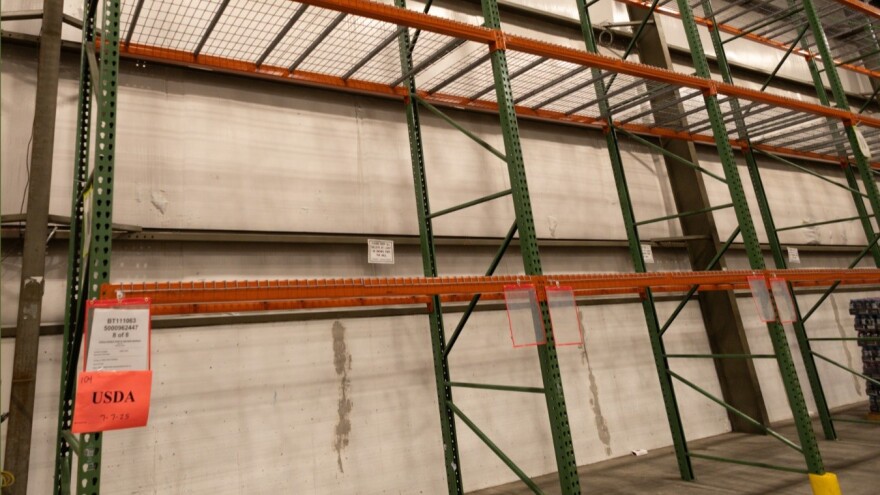BETHLEHEM, Pa. — Second Harvest Food Bank of the Lehigh Valley and Northeast Pennsylvania is pushing ahead through many unknowns.
The slashing of federal funding has set back its service to 200 partnering agencies and families in need across Lehigh, Northampton, Monroe, Wayne, Pike and Carbon counties, Second Harvest officials said.
“We have lost all of our fresh produce, meat, dairy, that we had coming in from local farmers due to funding cuts,” Associate Executive Director Sarah Wassel said.
“As well as with the Pennsylvania budget not passing yet, all of those monies are sitting in like a hold.
"We need continued advocacy, resources, and united voices to ensure no one in our community goes hungry."Second Harvest Food Bank of the Lehigh Valley and Northeast Pennsylvania
“Those funding streams we’re looking at, like [the State Food Purchase Program], as well as other commodities are now sitting in a holding pattern, so we don’t have the money to be able to purchase that product as well as we’re not receiving that product.”
“Every little bit helps,” Wassel said, as there’s always a need for canned chicken and tuna, pasta, beans, rice, peanut butter and child-friendly food, such as cereal and granola bars.
People can donate directly to a local food pantry or bring the goods by Second Harvest at 6969 Silver Crest Road in Upper Nazareth Township, Wassel said.
Last week, food bank officials met with a number of legislators and others to show the dire need firsthand.
“Our community came face to face with a harsh reality: Our shelves are nearly empty,” a July 23 Facebook post from Second Harvest reads.
“At our Legislative Breakfast, we welcomed 14 local, state and federal leaders to witness firsthand the growing food insecurity crisis across Pennsylvania.
“But this is just the beginning — we need continued advocacy, resources, and united voices to ensure no one in our community goes hungry.”

'We can't do anything'
Second Harvest already was scrambling after President Donald Trump and the U.S. Department of Government Efficiency canceled Pennsylvania’s $13 million contract with the Local Food Purchasing Assistance Program, officials said.
The program had Pennsylvania farmers paid to supply local food banks with fresh produce as facilitated by the U.S. Department of Agriculture.
"Due to the economic status of our area and the uncertainty of where we are at, some of our local warehouses who used to donate a lot of food have now had to cut back.”Second Harvest Associate Executive Director Sarah Wassel
Second Harvest reported such a cut would affect 40 farmers and 170 food pantries across its coverage area.
One figure from earlier this year showed the food bank, in just one month, fed more than 85,000 people in the Lehigh Valley and the surrounding region, including 23,000 children, 44,000 adults and 18,000 seniors.
Both the SFPP and the Pennsylvania Agriculture Surplus Program, which reimburses farmers for donating its products, are held up in the state budget process.
Wassel said those two are due for an increase “to help us try to alleviate the burden of losing LFPA.”
“But until that passes, we can’t do anything,” Wassel said.
“And then, due to the economic status of our area and the uncertainty of where we are at, some of our local warehouses who used to donate a lot of food have now had to cut back.”
'A vicious cycle'
One such facility is United Natural Foods Inc., which is in the process of closing its food distribution warehouse in Schnecksville, she said.
Recent legislation also includes cuts to The Emergency Food Assistance Program, from where USDA would buy commodities in bulk and send them to food banks for them to be equitably distributed.
“A lot of these cuts, it’s not just one person. It’s going to be the whole community that’s going to feel it, including your neighbors and your farmers.Second Harvest Associate Executive Director Sarah Wassel
The Supplemental Nutrition Assistance Program that bolsters grocery budgets of low-income families is also taking a hit, Wassel said.
“Our [SNAP] funding has decreased, their need has increased and we’re seeing food move out of our building at a rapid pace,” Wassel said.
Funding cuts, such as those with SNAP, also can affect grocery stores, as staffing and prices are impacted, as well as local farmers, since fresh produce and other offerings don’t get to the food bank as much as they once did — or at all.
“A lot of these cuts, it’s not just one person,” Wassel said. “It’s going to be the whole community that’s going to feel it, including your neighbors and your farmers.
“And there’s really no way to understand the devastation that these massive cuts could really cause.”
“So we just can’t keep the shelves full, and it’s just a vicious cycle.”


